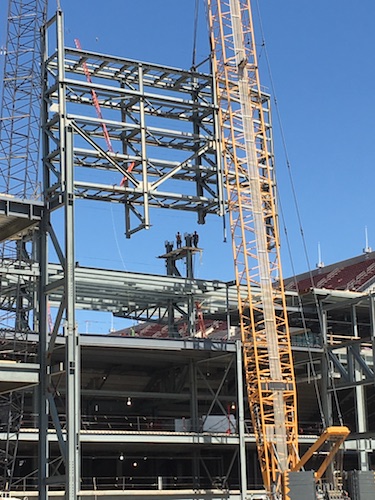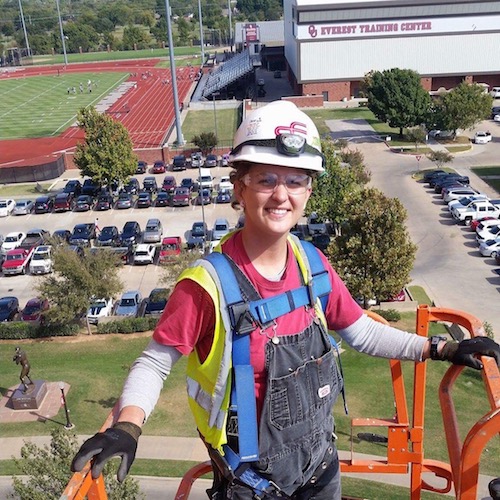When the Oklahoma Sooners decided in
2015 it was time for a major upgrade to the Gaylord Family-Oklahoma Memorial
Stadium, the university’s Board of Regents turned to the same IBEW contractor
it’s used on the historic football structure for decades.

|
| Atop the new south stand, IBEW members helped to install the new video board, which, at 167 feet by 47 feet, is the second largest in all of college sports.
|
The $160 million project, which was substantially completed in April, gave the south end of the stadium a completely new look, adding seats to surround the field for the first time in school history and topping them with the second biggest video screen in college sports. But the real work came below, where workers constructed an enormous new training and meeting facility for the football program, complete with offices, film rooms, therapy rooms, new locker rooms, an indoor track and a 25,000-square-foot weight room.
“This is an amazing transformation for this football program and for this stadium,” said Mickey Smith, a 35-year member of Oklahoma City Local 1141 and the construction manager for Shawver & Son, Inc., the project’s signatory electrical contractor. His team used more than 130 IBEW electricians on the job at its peak, and the total project involved more than 750,000 man-hours from all trades combined. “From the field, and for the players and coaches, it’s a totally different experience now.”
Before the latest renovation, Oklahoma’s stadium was a horseshoe shape, enclosed on the north side, with a free-standing set of bleachers in the south end zone. Local legend had it that the south end had been constructed in such a way that the open southeast and southwest corners couldn’t be filled in. Things just wouldn’t line up correctly, the naysayers said.
It’s possible they were right, because closing the gap required demolishing more than 35 percent of the existing structure, but the resulting bowl, which was completed in time for the 2016-17 football season last fall, had Sooner fans abuzz – so excited, in fact, that they crashed OU’s servers in 2014 when the plans were first revealed.
More than 1,800 new club seats, 60 loge boxes, 20 standard suites and two extra large “party suites,” are capped by the project’s most noticeable feature, a 7,849-square-foot, state-of-the-art video board that is the envy of the Sooners’ sporting rivals.
The board, which measures, 167 feet by 47 feet, comes with an impressive sound system that features 30 amplifiers and 24 subwoofers, according to a university release. The whole system runs on nearly 425,000 watts of power on gamedays, and it can be seen all the way from downtown Norman on the opposite side of OU’s campus.
Eric Sager, a 16-year member who served as Shawver’s general foreman on the job, said the enormous job was the biggest he’s been a part of to be completed in such a short amount of time. “They started tearing down the old stand almost as soon as the lights went off at the end of the 2015 football season,” Sager said, “and the first phase, which included every bit of the stadium that fans are able to use on gameday, was done before kickoff the next fall.”

|
| Ryan Drury, an apprentice at Oklahoma City Local 1141, works high above the new stand in the early stages of the project. The old stand had to be mostly removed in order to complete the stadium bowl and add in dozens of luxury boxes and thousands of seats.
|
That meant the bulk of the structure was finished in just under nine months, a remarkable feat. When the Sooners kicked off on Saturday, Sept. 10 last season, the team started a social media campaign, “#surrOUnded,” with the ‘OU’ capitalized for effect, to describe the new fan experience with the open corners filled in.
“It’s awesome, phenomenal the way they have it set up,” Sooner fan Carlos Caudillo told OUDaily during the annual spring game a few months before the work was complete. “It looks like a real top stadium now.”
“It made everything flow so much better,” OU Athletic Director Joe Castiglione told SoonerSports.com. “For the first time, now a fan can walk around from one side of the stadium to the other through the south end." The project also added 43 public restrooms and many more dining options to the stadium’s south side.
The work that was left included everything the general public wouldn’t regularly use – football facilities tucked under the south stands and a new, extended exterior façade that would nearly double the size of the previous office and training space.
“What’s especially unique about the new football facilities,” Sager said, “is that 90 percent of it – basically everything you can see in the finished space – is LED lighting. I’ve never done this much of it before, so it’s been nice to get to work so much with these energy-efficient fixtures.”
At the end of April, Sager said his crew had been reduced to just six electricians working through a final punch list and finishing some exterior lighting.
“Our company has been involved in this stadium for a long time,” Smith said, who himself ran the $75 million expansion in the early 2000s that added 2,500 seats and 27 suites to the upper and lower levels on the stadium’s east side. “Our long relationship with the university says a lot about the quality of the work our company and our IBEW electricians do on a consistent basis.”
“The opportunity to work on something directly related to the Sooners is a definite source of pride for our local union,” said Local 1141 Business Manager Dewayne Wilcox. “Like the OU team showing its best efforts on the field, our members strive for that same level of excellence on the job site.”
For Sager, who grew up an Oklahoma football fan, the job is one he’ll always remember. “It’s been really cool to be a part of this project,” he said. “Our crew has been a part of something that’s going to be here for a very long time – and hopefully for a few more national championships.”